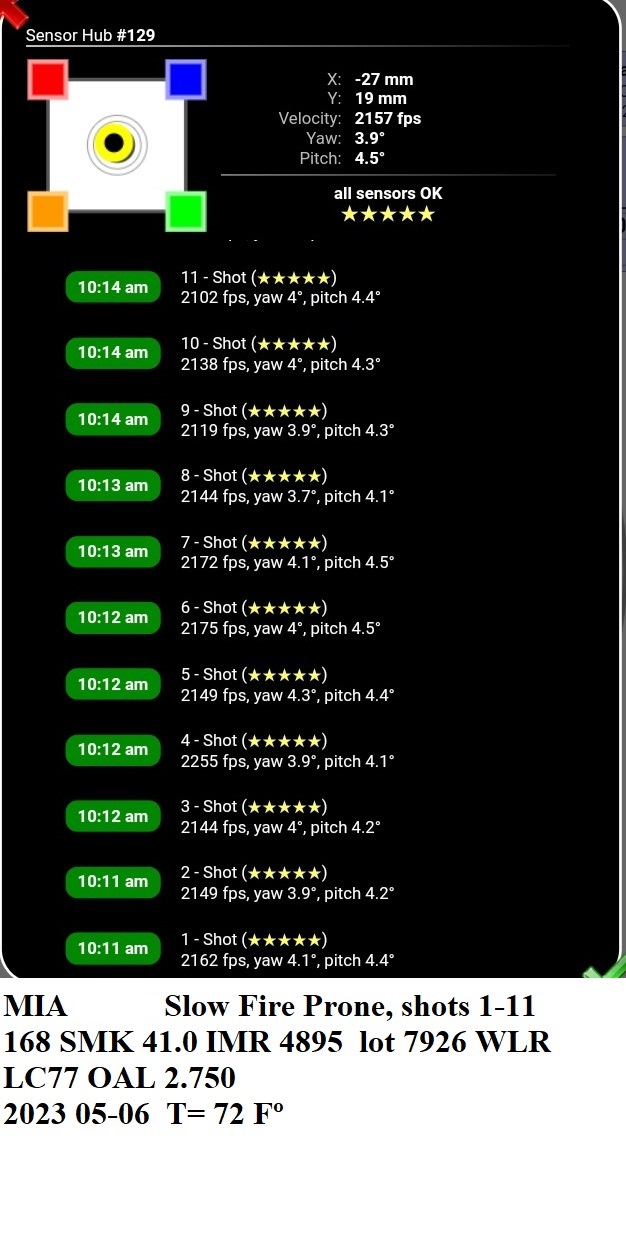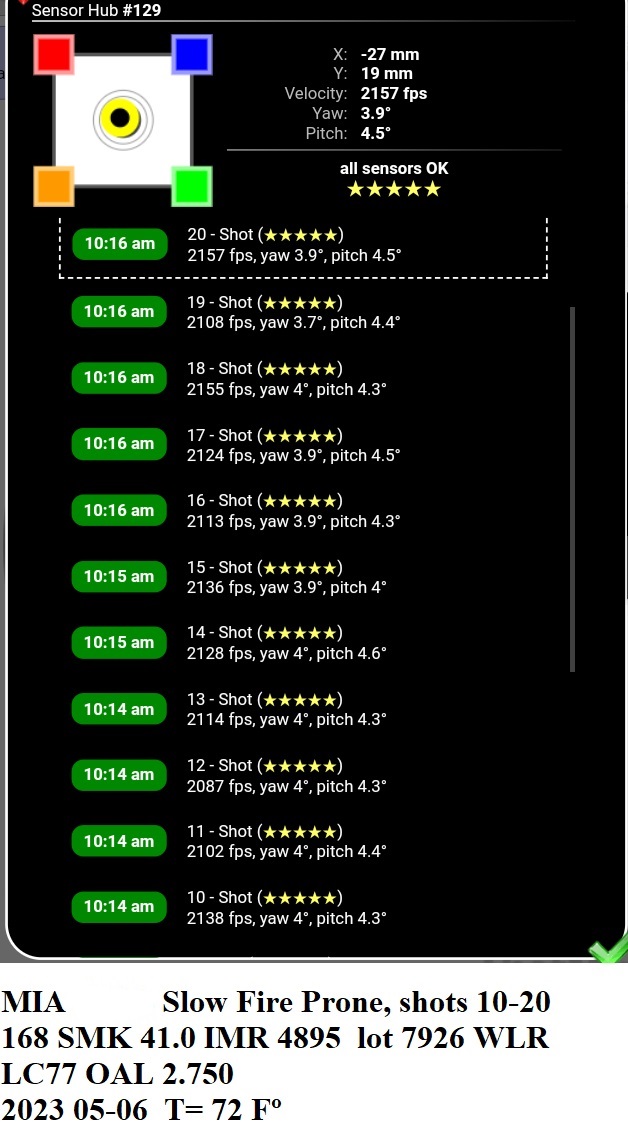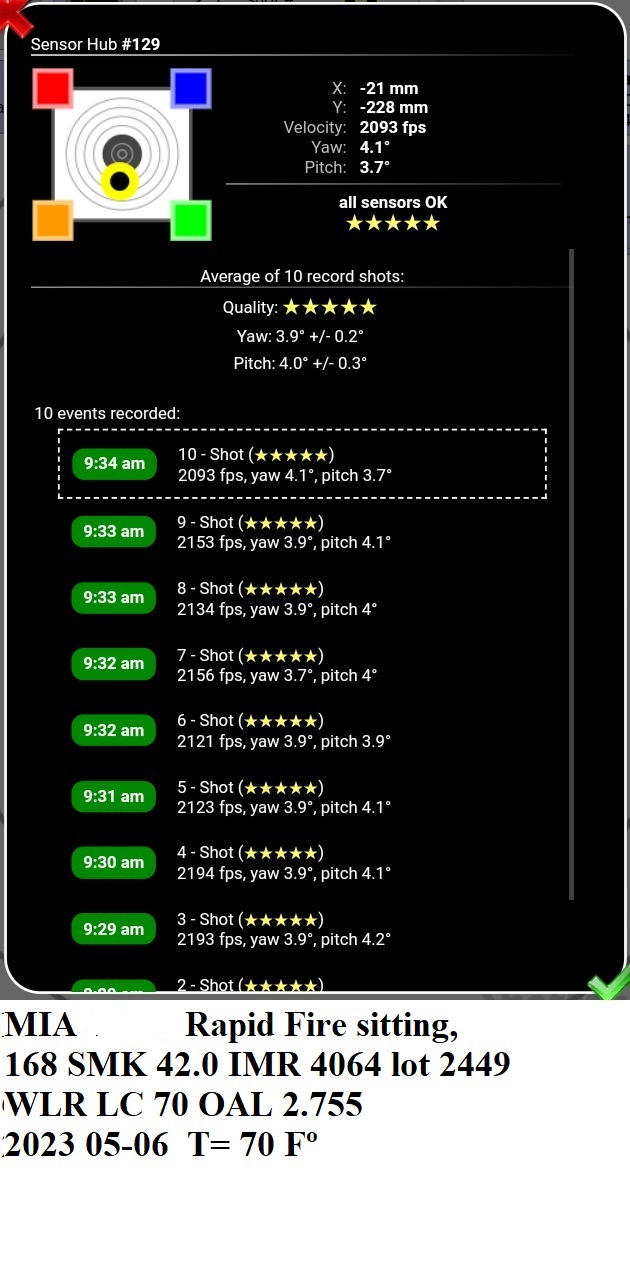Same here. Use bench to get dialed in. I shoot off sticks for BPCR, off hand for various rifles up to 300ish, and I mostly focus on ringing steel as well. And I have an orange and yellow 4 inch ball I shoot at 50 to 75 yards with my Henry 357 carbine.Again agree, TGT loads velocity is definitely secondary, but I still want the chrono stats.
It works out well, 50,100, 200 and 300 from my bench, 407 & 547 off my back deck and I have TGT's out to 760 when I shoot off the hay field.
I try to stay off the bench other than load development and zeroing. Punching paper bores the crap out of me, so I normally work on positions while ringing steel.
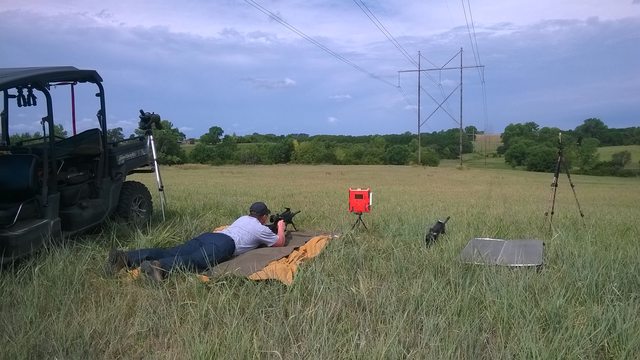
You are using an out of date browser. It may not display this or other websites correctly.
You should upgrade or use an alternative browser.
You should upgrade or use an alternative browser.
Speed or accuracy first when testing handloads.
- Thread starter Show Me
- Start date
sparkyv
Member
Always functionality.
Next precision (small groups).
Accuracy (hitting POA) becomes a consideration if I am beyond range of compensating with scope/sights adjustment.
Sometimes velocity; most recently, I've been chasing a low velocity (low recoil) load for SWMBO. And I've chased extra spicy loads in my 10mms! Great thrill!
Next precision (small groups).
Accuracy (hitting POA) becomes a consideration if I am beyond range of compensating with scope/sights adjustment.
Sometimes velocity; most recently, I've been chasing a low velocity (low recoil) load for SWMBO. And I've chased extra spicy loads in my 10mms! Great thrill!
Nature Boy
Member
- Joined
- Apr 21, 2015
- Messages
- 8,259
I shot an NRA regional prone match a couple of weeks ago that was using E targets for scoring. Part of the data that you get with the system is your bullet speed at the target. Here’s one of mine from the match. I was getting an average 1,922 fps and an SD of 17.6 for 25 shots at 600 yards
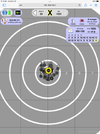
I have no idea how I’m supposed to use that data. I’m more focused on the fishtailing wind coming from 12 o’clock

I have no idea how I’m supposed to use that data. I’m more focused on the fishtailing wind coming from 12 o’clock
Last edited:
Charlie98
Member
SD of 17.8 for 25 shots at 600 yards
Good heavens!
westernrover
Member
- Joined
- May 4, 2018
- Messages
- 1,613
There are a lot of other factors in accuracy and controlling those variables takes a lot of work. A chronograph is relatively hard to foul up.
Using the chronograph is not about attaining maximum velocity, but about validating consistency.
The chrono can find velocity nodes and that's one of the steps toward accuracy.
Loading up some cartridges with a guessed charge weight and seating depth and seeing if they're accurate is not a good load development strategy.
If my load has a wide SD, accuracy is only a function of short range and a small sample size.
Using the chronograph is not about attaining maximum velocity, but about validating consistency.
The chrono can find velocity nodes and that's one of the steps toward accuracy.
Loading up some cartridges with a guessed charge weight and seating depth and seeing if they're accurate is not a good load development strategy.
If my load has a wide SD, accuracy is only a function of short range and a small sample size.
mcb
Member
I will buck the trend. When working up loads from USPSA competition handguns velocity is my first priority. You need to be above a particular velocity to make Power Factor. Once that minimum velocity is met then I start tweaking things to optimize accuracy. But compared to rifle shooting my accuracy requirements for USPSA ammunitions is relatively low.
With rifle loads accuracy is number one but I always measure velocity during my workup. Combining Quickloads simulations and measured velocity gives me a lot of insight into if the load being worked up is well behaved. If I see velocities or more critically the delta's between chargers that are dramatically different than Quickloads predicts I start looking for causes or mistakes in my loads or data. Its a nice sanity check that everything is right.
With rifle loads accuracy is number one but I always measure velocity during my workup. Combining Quickloads simulations and measured velocity gives me a lot of insight into if the load being worked up is well behaved. If I see velocities or more critically the delta's between chargers that are dramatically different than Quickloads predicts I start looking for causes or mistakes in my loads or data. Its a nice sanity check that everything is right.
Lennyjoe
Member
Accuracy is first on my list. If I can get top speed out of a round while maintaining accuracy that’s ok too. But what good is speed if you can’t hit the broad side of a barn…
bigpower491
Member
Accuracy always trumps speed in my book.
Weflyfast
Member
- Joined
- Nov 17, 2013
- Messages
- 498
Both are important - but it depends on the application -
Never saw a whitetail that could tell the difference of 200 fps......
If your stretching a cartridge out past 600yrds and need to wring out all a cartridge will give you....well you need to lean on it- .....but still need to be able to hit what you are aiming at!
Never saw a whitetail that could tell the difference of 200 fps......
If your stretching a cartridge out past 600yrds and need to wring out all a cartridge will give you....well you need to lean on it- .....but still need to be able to hit what you are aiming at!
murray brook
Member
Often heard this question asked . In any rifle I've ever had or still have I've always been able to achieve both, good hunting accuracy and good velocity.
Accuracy.
If a bullet goes whizzing by me at 3200 fps it accomplishes nothing more than that bullet whizzing by me at 2400 fps.
As the title of the WWII pamphlet my grandfather helped author; "Hits Count". If you can't hit the target, all the lead you spew is meaningless.
If a bullet goes whizzing by me at 3200 fps it accomplishes nothing more than that bullet whizzing by me at 2400 fps.
As the title of the WWII pamphlet my grandfather helped author; "Hits Count". If you can't hit the target, all the lead you spew is meaningless.
As with others, it depends on what rifle/purpose I'm loading for. For my elk hunt this year, for example, I wanted to be pushing 180 grain bullets at a minimum of 2700 fps from my 30-06, and more was better so long as accuracy was acceptable and I wasn't bumping max pressure. While I'm not a long-distance hunter by any means, I was trying to maximize my effective range within reasonable, safe limits for that specific purpose. I loaded to a minimum velocity first, and then went looking for accuracy once I was there. Obviously, I needed the accuracy as well or else the extra velocity wouldn't do me any good.
That's not how I normally work up a load. For most of my deer hunting or general shooting rounds, I pick a bullet I want to shoot, shoot a few groups or ladders with a few different powders and powder-charges to get an idea for which combination is giving me the better average accuracy. Sometimes I do this over a chronograph just so I have a general idea for what velocities I'm hitting with which powders, but not always. Then, I pick a safe load that is "good enough" in the accuracy department. The velocity usually falls wherever it will for these loads as I'm almost always hunting within 200 yards (and usually within 100 yards). Yes, there are ways to ensure better accuracy from reloads, but honestly it's not worth the components to me any more for my general deer hunting/shooting loads. It's easy enough to get acceptable accuracy in my hunting rifles now, so I just stop when I've hit that threshold. I'd rather spend the components practicing from field positions than refining a hunting load from the bench.
For my target rifle, I take a completely different approach. Accuracy (at the target distance) is the whole game. For this, I only care about velocity in a secondary way: more consistent means less vertical dispersion, and faster means less wind drift, which can (but might not) add up to better accuracy at the target distance. I'm still learning how best to develop loads and test for this, but accuracy is the focus.
That's not how I normally work up a load. For most of my deer hunting or general shooting rounds, I pick a bullet I want to shoot, shoot a few groups or ladders with a few different powders and powder-charges to get an idea for which combination is giving me the better average accuracy. Sometimes I do this over a chronograph just so I have a general idea for what velocities I'm hitting with which powders, but not always. Then, I pick a safe load that is "good enough" in the accuracy department. The velocity usually falls wherever it will for these loads as I'm almost always hunting within 200 yards (and usually within 100 yards). Yes, there are ways to ensure better accuracy from reloads, but honestly it's not worth the components to me any more for my general deer hunting/shooting loads. It's easy enough to get acceptable accuracy in my hunting rifles now, so I just stop when I've hit that threshold. I'd rather spend the components practicing from field positions than refining a hunting load from the bench.
For my target rifle, I take a completely different approach. Accuracy (at the target distance) is the whole game. For this, I only care about velocity in a secondary way: more consistent means less vertical dispersion, and faster means less wind drift, which can (but might not) add up to better accuracy at the target distance. I'm still learning how best to develop loads and test for this, but accuracy is the focus.
Similar threads
- Replies
- 23
- Views
- 2K
- Replies
- 12
- Views
- 824
- Replies
- 4
- Views
- 307


